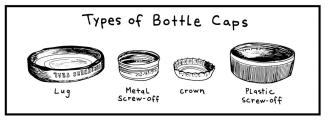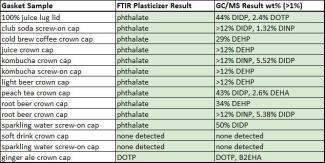Testing bottle cap gaskets for "Capped with Toxics" report

Sample preparation and testing
Cap gaskets were tested by FTIR spectroscopy at the Ecology Center's Healthy Stuff Lab, Ann Arbor, MI.
After removing a piece of the gasket with ethanol-cleaned metal tools, we placed a piece of the gasket onto the stage of a Nicolet iS5 Fourier Transform Infrared (FTIR) spectrometer with an attenuated total reflection (ATR) accessory. Absorbance spectra were collected from 4000-500 cm-1 with 4 cm-1 resolution using Omnic software. To identify composition, we used a combination of visual inspection of the spectral data along with searching for matches in a spectral library purchased from Thermo Scientific. Omnic Specta software was used to help identify mixed polymers. To determine a positive match, we required excellent alignment of absorbance bands in the experimental spectrum with a library spectrum or with a known reference standard.
More about FTIR spectroscopy
The output of FTIR spectroscopy is an absorbance spectrum that is unique to the molecular structure of the material. For example, a PVC spectrum is distinct from a polyethylene spectrum. When a plasticizer is present above approximately 1% by mass, absorbance bands from the plasticizer are apparent and identifiable. Ortho-phthalate esters are readily identifiable as a class by this method; i.e. the different phthalate congeners are difficult to distinguish from one another, so we report the result as "ortho-phthalate" (or shorthand "phthalate") without specifying. The data are best interpreted by a spectroscopy expert through a combination of visual verification of absorbance peak positions and patterns and matches to known reference spectra.
Third-party validation and speciation by GC/MS
A subset of 14 cap gaskets were shipped from the Ecology Center and analyzed at either TUV Rheinland (Arkansas) or Eurofins (Washington). These contract labs used organic solvent extraction and gas chromatography coupled with mass spectrometry (GC/MS) based on CPSC-CH-C1001-09.4, the Standard Operating Procedure for Determination of Phthalates, 2018. The gasket samples were tested for 12 ortho-phthalate esters plus four non-phthalate plasticizers (DOTP, ATBC, DINCH, and DEHA). Of the selected gaskets, eleven had been identified by FTIR to contain phthalates, one DOTP, and two no plasticizer. GC/MS results in each case were consistent with the FTIR findings, as shown in the table below.



